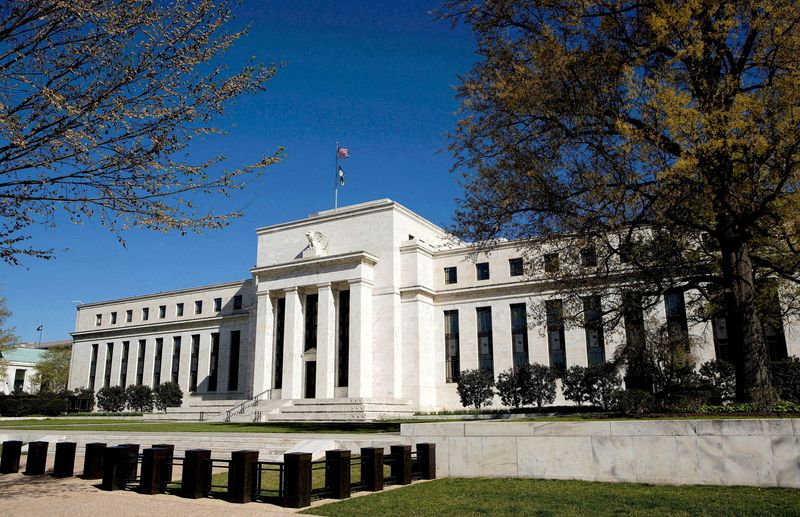Column-Fed’s steer as important for markets as policy action: McGeever
2024.09.25 12:05
By Jamie McGeever
ORLANDO, Florida (Reuters) – As former Federal Reserve Chair Ben Bernanke used to quip, “monetary policy is 98% talk and only 2% action.” Perhaps his numbers were a little exaggerated, but there’s no doubt that the financial market impact of policymakers’ signals can be just as powerful as their actual decisions.
If not more so.
Markets are forward-looking. It’s one of the fundamental pillars on which they’re built. So it should come as no surprise that policy guidance from Fed officials is such a strong driving force for investor behavior and asset prices.
But this foundational feature of the market is worth bearing in mind now that the Fed has fired the starting gun on its rate-cutting cycle, and debate swirls around the precise location of the neutral, natural and terminal rates of interest – and how soon these points will be reached.
Central to this discussion is “R-star,” the estimated interest rate that neither stimulates nor slows the economy, a theoretical number that’s impossible to determine in real time.
Much ink has been spilled about where the Fed thinks R-star is and what this says about the relative restrictiveness of financial conditions.
But that may not quite be the right question.
The economy and capital markets are often boosted not because R-star has actually been breached but because the Fed has indicated that it’s moving in the direction of this amorphous figure. Or, in many cases, simply because investors think it’s going there. So the actual location of R-star may be less important than the signaling around it.
THE SIGNAL AND THE NOISE
Before the U.S. central bank’s half-percentage-point rate cut last week, the federal funds rate was in the 5.25%-5.50% range – the highest in 17 years when adjusted for annual consumer inflation. Analysts at JP Morgan suggest real interest rates, when set against estimates of R-star, were the highest in 30 years.
Chicago Fed President Austan Goolsbee on Monday reiterated this point, noting that policy tightened substantially in real terms over the last year because inflation was slowing, giving the Fed plenty of room to loosen.
“Make no doubt about it – we’re hundreds of basis points above the neutral rate. If conditions continue like this, there are a lot of cuts to come over the next 12 months,” he said.
Of course, the flip side of Goolsbee’s assertion that policy effectively tightened even though the Fed didn’t raise rates is that reducing restrictiveness is effectively stimulative. And that is what markets are riffing off right now.
Consider that the three main U.S. equity indexes rose between 20% and 30% over the past year, high-yield bond spreads tightened by some 100 basis points, and most companies had no trouble refinancing their debt.
These are hardly hallmarks of highly restrictive financial conditions. This suggests that R-star may simply be higher than previously thought.
But – and forgive the circular logic – the intended impact of the elevated policy rate may also have been muted because of market sentiment. In other words, markets themselves pivoted quickly and began pricing in cuts, meaning conditions were looser than central bank theory would indicate.
RISK ON?
Even though investors’ appetite for risk may seem a little overdone, history shows it’s a rational response.
The fed funds rate is expected to be cut by another 200 basis points or so by 2026, according to Fed projections and market pricing. That’s substantial.
The experience of recent decades shows rate cuts of that order often precede or coincide with recessions, and in real terms, policy usually moves into stimulative territory. U.S. stocks on average rise 5% in the year after the Fed’s first cut, and as much as 18% if there is no recession, according to analysts at Raymond James.
Recession is not the base case for the U.S. central bank or financial markets.
Unprecedented inflation-busting rate hikes triggered deep recessions in the early 1980s, and even after rates came back down, they remained restrictive in real terms for the whole decade. The rose some 230% during this period.

So does it matter how investors think about R-star? Perhaps not, but they should absolutely be across how Fed officials view it and how it influences their thinking compared with, say, market-based financial conditions indices which may be sending contradictory signals.
(The opinions expressed here are those of the author, a columnist for Reuters.)
(By Jamie McGeever; Editing by Paul Simao)








